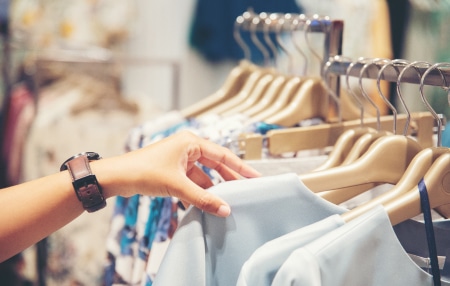
Question: Is there a better buzz than clothes shopping?
Answer: Yes, when you’re saving money while clothes shopping.
No matter what your financial situation, fashion is more than just a necessity – it can be a way to express yourself. The trouble is, if you’re not careful, keeping up with the latest trends can become very expensive. Fortunately, regardless of your finances – whether you’re fighting debt by using a debt management solution or simply looking to cut down on overspending – there are ways of building a stylish wardrobe without breaking the bank.
In this guide, we provide out top tips to saving money when clothes shopping. We also explore how shopping smart when it comes to fashion can help with debt management, and highlight the benefits of budgeting and mindful spending.
Clothes shopping tips: How to look great without breaking the bank
- Shop vintage: Sounds so much better than second-hand. If you’ve never given it a go, you’ll be amazed at what you can uncover in charity shops. The secret is to head to those in more affluent towns where the quality of the stock will be that much better. If you’re prepared to root through some weird stuff you can uncover some absolute gems.
- Max the discounts: Why pay full price for certain brand or designer names when you can pick them up at high-street discount stores with anything up to 80% slashed off the price tag? Again, you’ve got to be prepared to sift through the often-overloaded racks, but it’s so worth it when you stumble across the bargain of a lifetime.
- Subscribe: Sign-up for emails and newsletters from your favourite retailer and get a welcome discount and early alerts about sales and special events. Create a separate email account if you want to avoid cluttering up your inbox.
- Be sales savvy: Don’t buy something just because it seems like a bargain if you’ve got nothing to go with it. Chances are, you’ll never find anything to go with it and it’ll hang in your wardrobe shouting ‘waste of money’. Target gaps in your wardrobe and look for staple pieces that will complement what you already have and won’t date.
- Budget basics: You’ll never go wrong adding things to your wardrobe like a good-quality t-shirt, crisp white shirt, great jeans, quality shoes, nice leather jacket, decent winter coat. These are more likely to stand the test of time than anything with logos/slogans or gimmicky pictures.
- Avoid the weekend: Most retailers start marking down on a Thursday to prepare for the weekend rush. Get in ahead of the crowds and bag the best gear.
- Invest wisely: Spend the most on things that matter. Chances are you’ll only wear that bikini (girls) or those Speedos (boys?!) for a fortnight. So, don’t go mad buying the most expensive, designer versions. They’ll get ruined in the sun, sea, sand and chlorinated water anyway.
- Check around: Finding the best prices on the high street can be time consuming and tiring. So, do all your research online. It’ll save your feet and your finances.
- Consider renting: For that one-off special occasion such as a wedding or a ball, that party frock or fancy suit can cost a fortune and then just gather dust in the back of your wardrobe. There are plenty of places where you can hire something special.
How shopping smart helps with debt management
It goes without saying, but when you’re managing debt, every penny counts. This is especially true if you’re currently working through an Individual Voluntary Arrangement (IVA) or a formal Debt Management Plan (DMP).
By adopting smart shopping habits, you can save money that can then be redirected towards paying off debts. Instead of splurging on the latest trends, why not try to focus on building a versatile wardrobe with pieces that offer the best value for your money? Our top tips above can help with this. The savings you make over time can make a significant difference in cutting your debt and improving your financial stability.
What is mindful spending?
Put simply, mindful spending is the conscious act of making financial choices aligned with personal values and long-term goals, rather than ones based on impulse or peer pressure.
Although it may sound boring or overly-sensible, it’s important to understand that mindful shopping isn’t just about saving money at the expense of your wardrobe. It’s about making thoughtful financial choices that, in the long-term at least, will benefit your overall well-being.
A great way to put mindful spending into action is to start by putting together a monthly budget. If you’re looking to cut down on overspending on fashion and other non-essentials, a budget is a must-have.
To do this, simply determine how much you can afford to spend on clothing each month, without compromising other, more essential, financial obligations. Despite what you may think, paying your rent, mortgage, and utility bills should always be a higher priority than a fresh pair of trainers or a new outfit for a night out.
Once you have your budget in place, stick to it religiously. And when it does come to purchasing new clothes, try to prioritise your spending on the most practical items that offer the most value and longevity. Remember – fast fashion is an enemy to financial stability. By doing this and keeping your spending on clothing in check, you can avoid accumulating unnecessary debt and maintain a healthy financial outlook.
If you are struggling with significant levels of debt, seeking professional advice is always a good idea. Visit MoneyHelper for free advice, or speak with one of our expert advisors today. Here at MoneyPlus, we offer expert guidance on debt management, helping you take control of your finances and work towards a healthier budget.

To discover more about how to manage your debt and to receive free debt advice, you can visit www.moneyhelper.org.uk.

